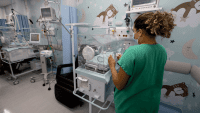Building the infrastructure for Magnet® and just culture at a small community hospital took an organized effort of nurses, physicians, and administrators. In this culture trifecta, nurses, physicians, and the entire organization formed a united team in the pursuit of healthcare excellence.
At Valleycare Health System in Pleasanton, California, the journey to Magnet Excellence™ began in 2006 on a shoestring budget supplemented by generous grants. The chief executive officer (CEO), chief operating officer (COO), and chief nursing officer of this not-for-profit, nurse-led, 212-bed community hospital believed attaining Magnet Recognition® would validate the organization’s existing culture, distinguish the outstanding collaborative care it provides, and recognize the contribution of each organization member to providing excellence as a united team. These leaders also realized that the hospital’s intergenerational, interdisciplinary workforce was a powerful asset for dynamic change and visionary development. They began building the framework for the Magnet journey. Five years after beginning this journey, our organization is nearly ready to submit an application to the Magnet Recognition Program®.
Building the infrastructure
Building the infrastructure for our Magnet journey required the shared endeavors of the nursing and medicine departments as well as the organization as a whole. Senior leaders recognized the Magnet journey and creation of a just culture were uniquely aligned to transform our hospital into a revolutionized, accountable-care organization. Uniting medicine, nursing, and the organization as a whole to reach the pinnacle of healthcare recognition required leaders to align the entire organization, including employees and independent contractors (such as physicians) into a professional, collegiate, interdisciplinary team vested in the organization’s mission, vision, and strategic plan.
Just culture unites all healthcare workers by creating shared responsibility for patient safety, increasing quality of care and awareness, promoting retention through trust, strengthening morale among staff pursuing excellence as a team, and maximizing opportunities for organizational learning. Just culture turns mistakes and errors into opportunities to learn for the purpose of improving patient outcomes. (See What is a just culture? by clicking the PDF icon above.)
Laying the foundation
Change and innovation involve risk, creativity, and trust. Leaders must recognize that employees best understand the nature of their particular job duties and are uniquely able to identify areas of improvement and advancement. But getting a multigenerational, interdisciplinary workforce to find middle ground is no easy task. At Valleycare, Magnet principles were introduced through in-service programs, intranet education modules, newsletters, and staff meetings. They were introduced to nursing staff by a team of nurses and to the medical staff by a team of physicians and nurses.
A gap analysis was conducted to examine what processes and data supporting a Magnet culture already existed. Magnet consultants were brought in twice to reexamine our healthcare system in the context of Magnet qualities, make suggestions for improvement, and validate existing structures. Changes and improvements were implemented by collaborative nursing and medical councils to continue to align the organization with evidence-based practices and achieve optimal patient outcomes. In 2008, just culture was implemented to strengthen the hospital’s commitment to the pursuit of excellence and Magnet designation.
Finding middle ground: Uniting nursing, medicine, and the organization
Inadequate communication is one of the biggest problems in any industry. Open communication encourages engagement and empowerment. It requires active listening and genuine presence for the message to be truly meaningful.
Creating an environment that allows an interdisciplinary team to speak openly and freely about patient care, care concerns, and patient outcomes can cause anxiety in healthcare workers. Teaching nurses and physicians to speak the same language also can pose challenges. To promote patient safety and positive outcomes, leaders must create an environment in which information flows freely without concerns, such as fear of retaliation or the need to follow a communications “hierarchy.”
Our hospital adopted an open-door policy to invite all employees to express concerns about patient care and make suggestions for improvement. Patient safety rounds were initiated to give senior leaders a chance to visit patient-care areas and talk directly with staff in their normal working environment. TeamSTEPPS™, a program of the Agency for Healthcare Research and Quality, was introduced and shared with most staff members and physicians to teach each discipline how to communicate with each other clearly, using meaningful phrases and similar word choices to express concerns or make suggestions without fear of retribution or retaliation.
Finally, the hospital adopted a zero-tolerance policy for verbal abuse, including derogatory names, bad-mouthing, and other disrespectful behaviors. The management team introduced the “Nothing about me without me” program, in which all problems and safety concerns are addressed with the person who may be contributing to a potential problem as soon as possible by those who identified the problem. The aim is to create a nonpunitive culture of shared learning.
Creating collaboration
Historically, healthcare systems have been managed by physicians. But at our hospital, the CEO and COO are nurses. A team of physicians, nurses, and community members on the board of directors supervises the hospital. Physicians and nurses work interdependently as professional colleagues. Both groups support professional autonomy within each other’s discipline. Interdisciplinary rounds are conducted on every unit with daily physician involvement. The medical director of the intensive care unit (ICU) is present for interdisciplinary rounds in the ICU, and a physician attends hospital-wide nursing rounds and unit-based case management rounds nearly every morning.
Physician involvement
A key component for success is integrating physicians into the Magnet and just culture process. This is easier said than done. Valleycare has a voluntary attending staff of contract physicians whose priorities may not align perfectly with the hospital’s needs. So the importance of strong relationships between physicians and other disciplines must be reinforced.
Physicians don’t start the day planning to be ineffective in communicating or collaborating, but daily tasks and constant interruptions can impede effective communication. Also, medical training involves a hierarchical system that promotes knowledge and technical competency.
We started building the infrastructure for Magnet and just culture by introducing educational programs and seminars highlighting the importance of effective communication and collaboration, and discussing how these activities relate to optimal patient outcomes. We stressed the importance of physician-to-physician interactions and the need for primary-care clinicians, specialists, and consultants to communicate with each other to ensure a well-coordinated treatment plan with realistic expectations. Ideally, these professionals take a unified approach when discussing options with the patient and family. However, some physicians need additional training on how to hold difficult conversations with patients concerning palliative care, comfort care, or end-of-life care. We’ve introduced the TeamSTEPPS team-building program and SBAR (Situation, Background, Assessment, Recommendation) communication scripts to improve communication and collaboration among physicians and nurses. We plan to hold more workshop sessions and individualized one-on-one sessions to help physicians in other common situations. With the goal of advancing best practices, we hope to raise physician awareness and provide easy-to-use tools to help them improve communication and process efficiency.
A shared vision
Members of a culture trifecta recognize all healthcare disciplines. The trifecta enhances professional autonomy, incorporates all healthcare team members into decision-making bodies, teaches communication skills, and engages physicians around the value of communication and collaboration. Such a culture fundamentally enhances patient outcomes and brings about the highest-quality care. Building the infrastructure for Magnet and just culture is an ongoing journey that requires a shared vision and the cohesive efforts of nurses, physicians, and the entire organization.
The authors work at Valleycare Health System in Pleasanton, California. Erin Shannelle Bashaw is a medical-surgical nurse. Alan H. Rosenstein is the medical director of clinical efficiency and case management. Karen Lounsbury is the director of staff education.



















3 Comments.
Feel free to contact me at ebashaw@valleycare.com
I would like to speak with you regarding the article and how you did this.
Great Job.
We are using this model at Bronx Lebanon.
Great job! Makes me proud to be part of your team. We will keep the Magnet Journey strong together.